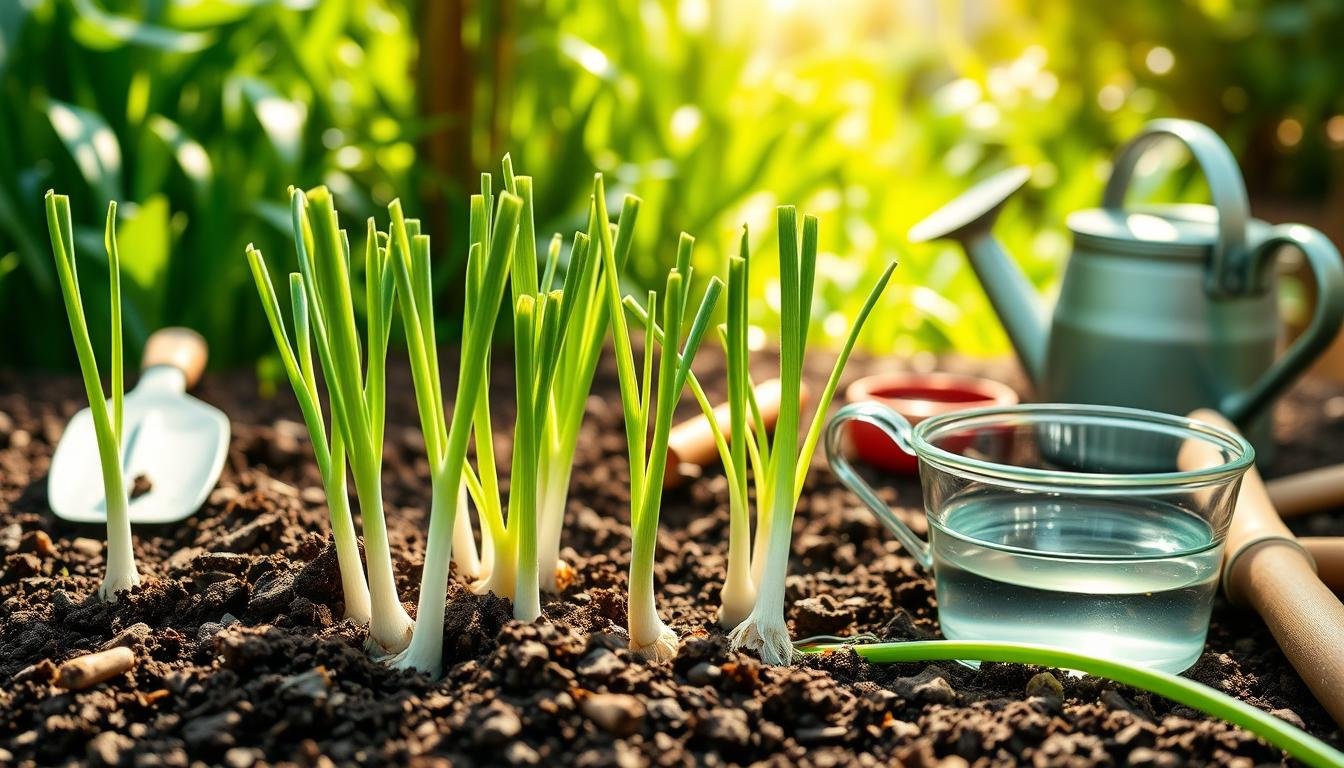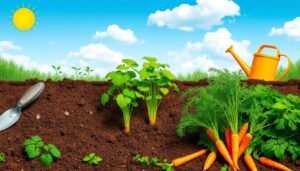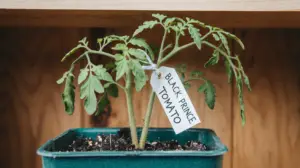Did you know green onions can grow from seed to harvest in about 50 to 60 days? This makes them perfect for home gardeners who want quick results. You might call them scallions, bunching onions, or spring onions. They can be grown from the root ends of store-bought green onions. If you’re interested in learning more, check out this guide on how to grow an onion from an onion.
In this article, we’ll show you how to grow green onions step by step. We’ll cover practical methods, the best planting types, where to plant them, and how to care for them. With our tips, you’ll be growing fresh green onions in no time.
Table of Contents
Introduction to Green Onions
Green onions, also called scallions or bunching onions, are a favorite in kitchens worldwide. They have a mild taste and are very versatile. This makes them a must-have in many homes.
These leafy veggies are packed with vitamins A and C, iron, calcium, and fiber. They not only add flavor to dishes but also boost your health. You can keep harvesting them by cutting the green tops, which encourages new growth.
To grow green onions, use a pot that’s at least 6 inches deep and as wide as possible. This depth helps their shallow roots grow well, whether they’re alone or in groups. In warm places, like subtropical areas, you can plant them all year, getting lots of harvest in little space.
When growing green onions, remember they need well-drained, rich soil, regular water, and lots of sunlight. With the right care, your kitchen will always have fresh green onions. This will make your meals more flavorful and nutritious.
Benefits of Growing Green Onions at Home
Growing green onions at home has many benefits. It helps you save money and enjoy fresh ingredients all the time. Just soak the ends in water, and new growth starts in a few days.
Green onions add flavor to many dishes, like salads and soups. They can be regrown multiple times, saving you money. Plant them close together to use space wisely, even in small gardens.
Green onions are also good for you, full of vitamin C and potassium. Adding them to your meals boosts your health and creativity in the kitchen. Growing them at home is a smart and healthy choice.

Types of Green Onions to Consider
Knowing the different types of green onions is key when picking which to grow. Scallions and bulbing onions are two popular choices. Scallions, or Allium fistulosum, are loved for their tender stalks and mild taste. They’re great raw or cooked, adding a fresh flavor to food.
Bulbing onions, or Allium cepa, can also be picked early. They’re often grown for their bulbs, but you can harvest their green tops early too. This makes them great for gardeners looking to get the most from their harvest.
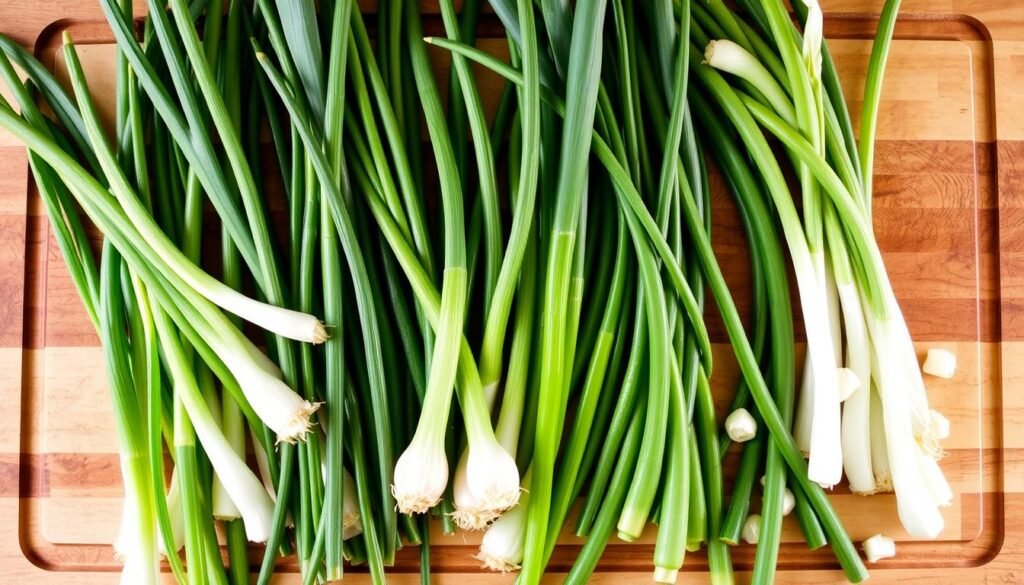
| Type | Scientific Name | Harvest Time | Flavor Profile |
|---|---|---|---|
| Scallions | Allium fistulosum | 60-95 days | Mild, sweet |
| Bulbing Onions | Allium cepa | 70-120 days | Strong, robust |
Learning about these green onions helps you pick the right one for your kitchen and garden. Whether you prefer scallions’ delicate taste or bulbing onions’ bold flavor, both can make your meals better.
Where to Plant Green Onions
Choosing the right planting locations is key for growing green onions. They do best in places with lots of sunlight. Look for a spot that gets 6 to 8 hours of direct sun a day.
Here are some top planting locations:
- Garden Beds: These are perfect for green onions, as long as the soil is rich and drains well.
- Containers: If you’re short on space, pots with good drainage can work great for growing green onions.
- Cold Frames: Use these for early spring planting to start the growing season early.
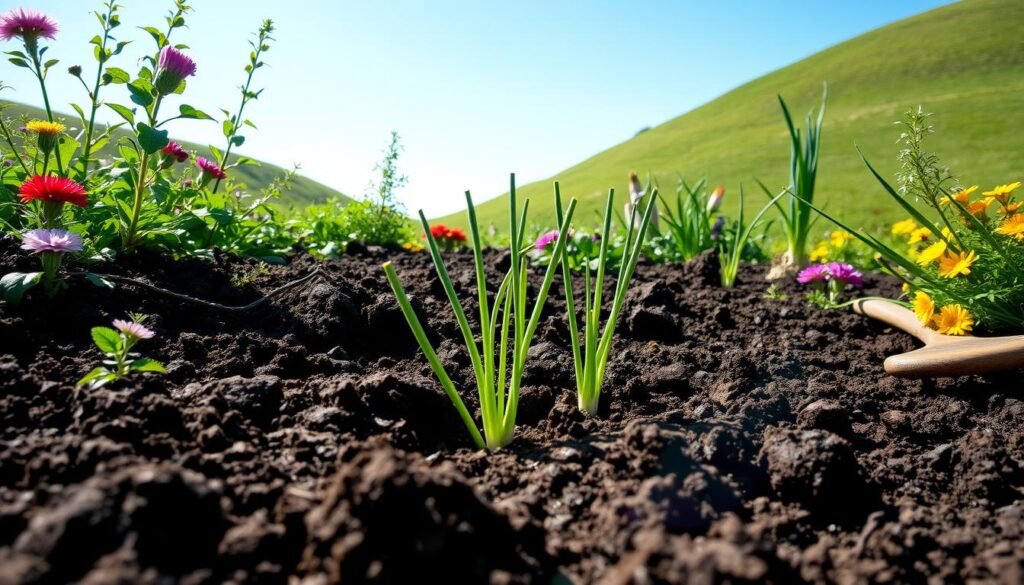
Soil preparation is also important. Green onions like nutrient-rich, sandy loam with a slightly acidic to neutral pH. Adding compost to the soil can help a lot. Knowing where to plant green onions and making sure they get enough sun will help your garden thrive and give you a big harvest.
How to Grow Green Onions
To grow green onions well, you need to pick the right soil, fertilizer, and sunlight. Start by choosing the best soil and sunlight for your plants. These choices greatly affect how well your onions grow.
Choosing the Right Soil and Fertilizer
Green onions do best in fertile, draining soil with a pH of 6.0 to 7.0. Adding organic compost helps with nutrients. Make sure your soil and fertilizer give green onions what they need to grow strong.
Check the soil moisture often. Water your onions about once a week. Adjust this based on the weather.
Sunlight Requirements
Green onions love lots of sunlight, needing 14-16 hours a day indoors. The right sunlight is key for growth. Choose a spot for at least six hours of sunlight a day.
With the right care in sunlight and water, you’ll have a bountiful harvest. Your onions will be ready in just a few weeks.
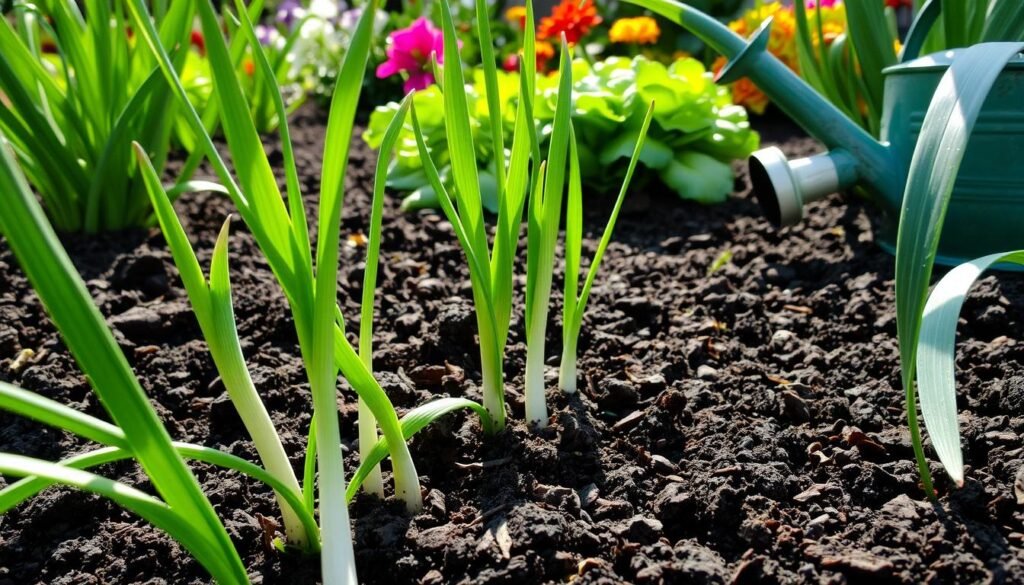
When to Plant Green Onions
Knowing when to plant green onions can make gardening better and more rewarding. By planting at the right times, you can grow more and have a steady supply all year. Here are some tips to help you plant green onions at the best times.
Seasonal Planting Strategies
To get the best results, follow these planting timelines:
- Indoors: Start your green onion seeds indoors about eight to ten weeks before the last frost. This gives them a head start for a longer harvest season.
- Outdoors: For outdoor planting, sow green onion seeds 2-4 weeks before the last expected frost date. This timing works well with spring’s changing weather.
- Seed Depth and Spacing: Plant seeds at a depth of ¼ inch and space them 1 inch apart. Once seedlings emerge, thin them out for better growth.
- Clumping: When transplanting outdoor green onions, group them in clumps spaced 6 inches apart. This helps with air circulation and strong stalk growth.
Keep an eye on your green onions’ growth and health. They’re ready to harvest when their stalks are pencil thick or thicker. Using these planting strategies will help you have plenty of green onions all year.
| Planting Method | Timing | Details |
|---|---|---|
| Indoors | 8-10 weeks before last frost | Start seeds for extended harvesting. |
| Outdoors | 2-4 weeks before last frost | Ideal for spring planting. |
| Seed Depth | – | Plant seeds ¼ inch deep. |
| Seed Spacing | – | Space seeds 1 inch apart. |
| Clump Spacing | – | Plant clumps 6 inches apart outdoors. |
Growing Green Onions Indoors vs. Outdoors
Green onions can grow in many places, making them great for any garden. You can grow them indoors or outdoors, each with its own benefits. When growing in containers, it’s important to use the right soil and a deep enough container. A container at least 6 inches deep helps the roots grow well.
Indoors, you can control the environment better. It’s key to make sure your green onions get enough sunlight. They do best near a sunny window or with grow lights. Having fresh green onions in the kitchen is a big plus. You can use shallow pots for indoor gardening, making it easy to start.
Outdoor green onion cultivation is different. These plants can grow up to 18 inches tall. Ground soil is better for drainage and root growth if planted right. Make sure to space plants well to help them grow healthy and avoid diseases.
| Aspect | Indoors | Outdoors |
|---|---|---|
| Sunlight | Requires direct sunlight or grow lights | Natural sunlight promotes vigorous growth |
| Container Size | Minimum 6 inches deep | Based on available space in garden |
| Watering | May need frequent watering up to 3 times daily in summer | Typically requires about 1 inch per week |
| Pest Management | Less exposure to pests | Watch for common garden pests |
| Harvest Time | Harvest time can be flexible | Usually ready between 70-90 days |
Both indoor and outdoor green onion growing can give you fresh, tasty results. They need little care and can regrow from leftovers. This makes them a great choice for both new and experienced gardeners.
Green Onion Care Instructions
Proper care is key for green onions to grow well. This section will cover watering and pest control. This will help your green onions do great in your garden or kitchen.
Watering Techniques and Frequency
Knowing how to water green onions is important. They like the soil to be moist all the time. This helps them grow fast. Here are some tips for watering:
- Water deeply but not too often to help roots grow strong.
- Try to give them about one to two inches of water each week. Adjust this if it rains a lot.
- Check the soil often to make sure it’s not too wet or too dry.
Change how often you water based on the weather and where you live. In hot weather, you might need to water more. In cooler times, you might water less.
Pest Management for Healthy Growth
Keeping pests away is important for green onions to stay healthy. Pests like slugs and onion maggots can slow them down. Here are some ways to keep pests away:
- Look at your plants often for signs of pests.
- Use natural pest killers like diatomaceous earth or neem oil.
- Attract good bugs like ladybugs and lacewings. They eat bad bugs.
By following these pest control tips, you can make a great place for your green onions to grow. A careful gardener will have happy, healthy plants that grow a lot.
| Aspect | Recommendation |
|---|---|
| Watering Frequency | 1-2 inches per week |
| Soil Moisture | Keep consistently moist |
| Pest Control Method | Organic solutions (neem oil, diatomaceous earth) |
| Pest Types | Slugs, onion maggots |
| Beneficial Insects | Ladybugs, lacewings |
Green Onion Harvest Techniques
Learning how to harvest green onions can make gardening more enjoyable. Knowing when to pick them ensures great taste and keeps the plant healthy for more growth. This part talks about the best times and ways to harvest without harming the plant.
When to Harvest Your Green Onions
Harvesting at the right time is key for the best flavor. Green onions are ready when they’re 8 to 10 inches tall. This size is great for salads or cooking because it tastes mild.
Look for yellow leaves or leaves that start to flop over. This means it’s time to harvest. You can pick your onions many times during the growing season. Some varieties are ready to harvest at any stage, even as microgreens.
How to Harvest Without Damaging the Plant
It’s important to harvest green onions the right way to keep them growing. Here’s how:
- Use a sharp knife or garden scissors to cut at the base of the stalks, ensuring a clean cut.
- Avoid pulling the onions directly out of the soil, as this can damage the roots and hinder future growth.
- Leave at least one inch of the green stalk above the soil to allow for regrowth.
By learning these techniques, you can have a steady supply of tasty greens all season. Taking the time to learn when and how to harvest will help you grow a more abundant and sustainable crop.
| Harvest Timing | Stalk Height | Flavor Profile |
|---|---|---|
| First Harvest | 8-10 inches | Mild |
| Subsequent Harvests | 6-8 inches | More pronounced |
| As Microgreens | 2-4 inches | Intense |
Best Practices for Cultivating Green Onions
To get the most out of your green onions, follow the best practices. This means keeping the soil healthy and learning how to harvest continuously. Good soil and careful harvesting lead to better yields and quality onions.
Maintaining Soil Health
Soil health is key for green onions to grow well. Here are some tips for a great harvest:
- Crop Rotation: Change what you grow in the soil to keep it rich and pest-free.
- Organic Fertilization: Add compost or organic fertilizers to keep the soil full of nutrients.
- Soil Testing: Check the soil’s pH and nutrient levels often to adjust your fertilizers.
These steps help your soil stay healthy, giving your green onions the best chance to thrive.
Continuous Harvesting Methods
Using continuous harvesting keeps your green onions coming. Here’s how to keep them coming:
- Timely Harvesting: Pick green onions when they’re the right size but before they flower, usually 6 to 10 inches tall.
- Staggered Planting: Plant seeds every few weeks for a steady supply all season.
- Preserving Freshness: Keep harvested onions fresh by storing them upright in water in the fridge for about a week.
By focusing on soil health and using smart harvesting, you can enjoy green onions all year.
| Practice | Description |
|---|---|
| Crop Rotation | Rotate green onions with other crops to improve soil fertility and minimize pests. |
| Organic Fertilization | Enhance soil nutrients using compost and organic fertilizers for better growth. |
| Soil Testing | Evaluate soil conditions to ensure optimal pH and nutrient levels are maintained. |
| Timely Harvesting | Harvest green onions at the right size to maintain flavor and freshness. |
| Staggered Planting | Plant seeds at intervals for a consistent supply of green onions throughout the season. |
| Preserving Freshness | Store harvested onions upright in water for prolonged freshness in the refrigerator. |
Conclusion
Growing green onions is easy and rewarding for all gardeners. This guide offers key tips to improve your gardening. You’ll get fresh green onions for your cooking, adding flavor to many dishes.
Plant green onions in spring or fall, about 2 to 4 weeks before the last frost. They love full sun, needing at least 6 hours of sunlight daily. Watching them grow is fun for kids and adults, with germination happening in just 7 to 14 days.
Remember, gardening is about being green. Reuse green onion roots to grow more. This way, you always have fresh ingredients. Whether on a windowsill or in your garden, these tips will help you grow a lot of green onions. It makes gardening fun and rewarding.

